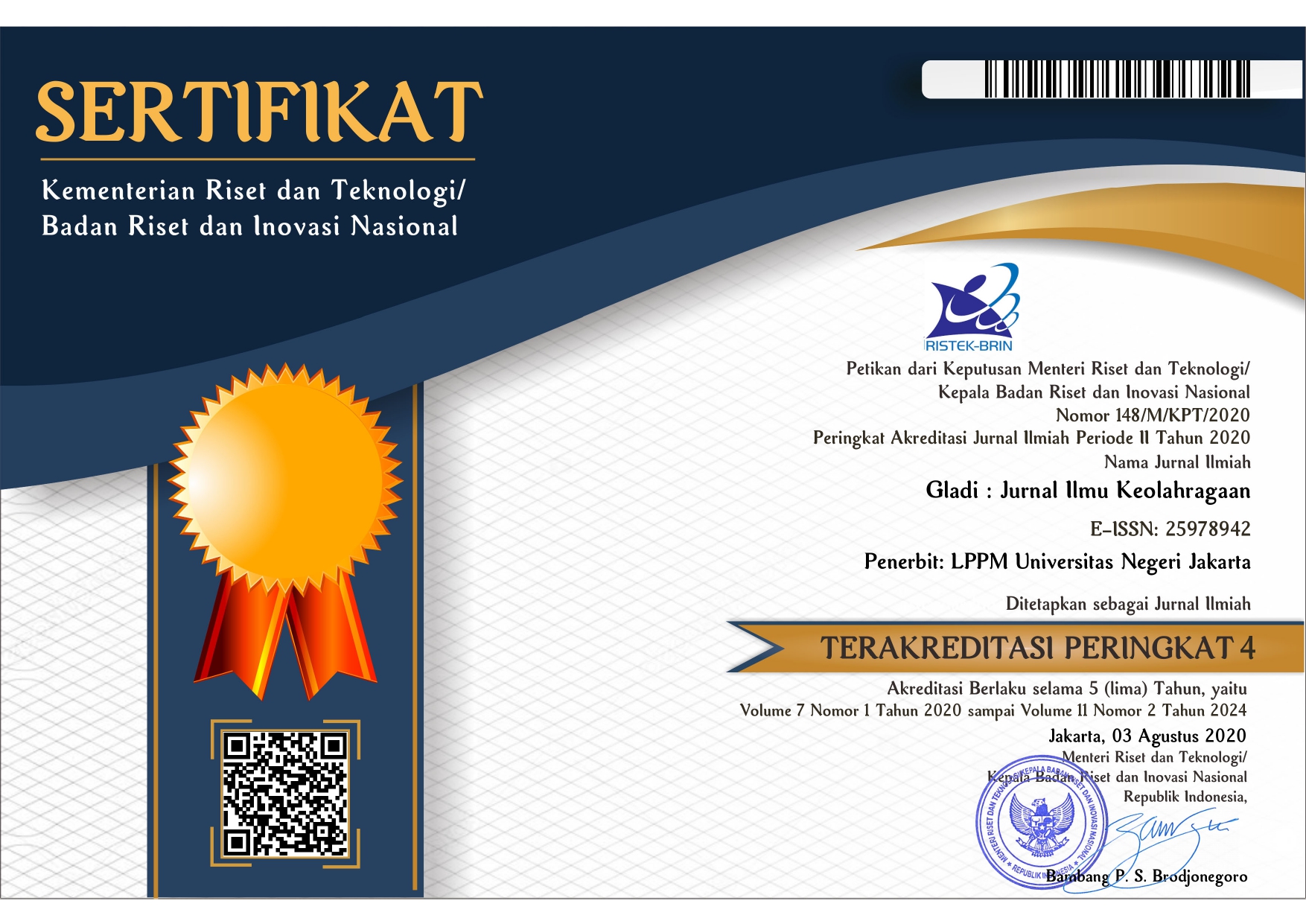DEVELOPMENT OF RESISTANCE-BASED ARCHERY TRAINING MODELS FOR ATHLETES AGED 13-15 YEARS
DOI:
https://doi.org/10.21009/GJIK.125.08Keywords:
Exercise Models; Physical; Archery; Resistance BasedAbstract
The purpose of this study was to produce a resistance-based archery training model for athletes aged 13-15 years. The method used in this research is Research and Development. The study was conducted at DSR Archery Club Depok City and the research subjects were athletes aged 13-15 years. This research begins with needs analysis, product planning, development, implementation and evaluation. The instruments used were the 30 M Archery Test in the sport of archery, an analysis of the need for in-depth interviews to coaches at the archery club and an assessment questionnaire to experts to test the validity of variations in the training model. Based on research data consisting of needs analysis, product design, expert validation, small and large group trials, and effectiveness tests. The conclusion is first, resistance-based archery training model for athletes aged 13-15 years can be developed and applied in training archery skills and muscle strength training. Second, the exercise model developed based on research data obtained effective results for athletes aged 13-15 years
Downloads
References
Aryani, K. D. (n.d.). EFFECT OF PLANK EXERCISE ON ARM MUSCLE ENDURANCE AND ARHCERY. 15, 1–10.
Carrillo, A.E., Christodoulou, V.X., Yiannis Koutedakis, Y., Flouris, A.D., (2011). Autonomic nervous system modulation during an archery competition in novice and experienced adolescent archers. J. Sport. Sci. 29 (9), 913e917.
Dhawale, T. (2018). Effect of Upper Extremity Plyometric Training on Strength and Accuracy in Archery Players. Journal of Medical Science And Clinical Research, 6(12). https://doi.org/10.18535/jmscr/v6i12.22
Harsono. (2015). Kepelatihan olahraga. (teori dan metodologi). Bandung: Remaja Rosdakarya.
Humaid, H. (2014). Influence of arm muscle strength, draw length and archery technique on archery achievement. Asian Social Science, 10(5), 28–34. https://doi.org/10.5539/ass.v10n5p28
Kim, J.-P. (2008). The Effect of Balance Exercise on Postural Control and Shooting Record in Archers. Korean Journal of Sport Biomechanics, 18(2), 65–74. https://doi.org/10.5103/kjsb.2008.18.2.065
Laishram, D., Kumar, R., & Sandhu, J. S. (2008). Effects of strength training and jatamansi on reducing hand tremor amongst archers. Archivos Venezolanos de Farmacologia y Terapeutica, 27(2), 105–109.
Park, J.-M., Hyun, G.-S., & Jee, Y.-S. (2016). Effects of Pilates core stability exercises on the balance abilities of archers. Journal of Exercise Rehabilitation, 12(6), 553–558. https://doi.org/10.12965/jer.1632836.418
Pate et al., (2007) Dasar-Dasar Ilmiah Kepelatihan, Saunders College Publishing, Philadelphia New York Chicago.
Puspitasari, N. (2019). Faktor Kondisi Fisik Terhadap Resiko Cedera Olahraga Pada Permainan Sepakbola. Jurnal Fisioterapi Dan Rehabilitasi, 3(1), 54–71.https://doi.org/10.33660/jfrwhs.v3i1.34
Sezer, S. Y. (2017). The Impact of Hand Grip Strength Exercises on the Target Shooting Accuracy Score for Archers. Journal of Education and Training Studies, 5(5), 6. https://doi.org/10.11114/jets.v5i5.2194
Sharma, H. S., Singh, N. S., & Singh, T. B. (2015). Effectiveness of six weeks training on static strength of archery players. 1(5), 34–36.
Subarjah. (2012). Latihan Kondisi Fisik. UPI.
Sugiyono. (2015). Metode penelitian dan pengembangan. Bandung. Alfabeta
Tinazci. (2011). Shooting dynamics in archery: A multidimensional analysis from drawing to releasing in male archers. Physical Education and Sports Department, Near East University, Nicoisa 0023, Cyprus
Wilmore, J.H. & Costill, D.L. (1994) Physiology of sport and exercise. Human Kinetics, Champaign.
Yudiana, Y. Subarjah, H. & Juliantine, T. (2009). Teori Latihan. Bandung: FPOK UPI







